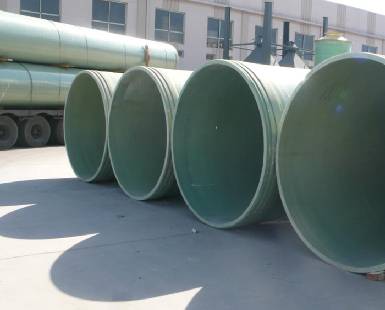Since the mid to late 1980’s Fiberglass Composite Pipe Fittings has continued to grow in applications and usage. Technological advancements in the filament winding process, corrosion resistance, education and outreach, and strong market forces have contributed to the popularity of fiberglass pipe. Definitions of what constitutes large-diameter pipes can vary, but generally speaking they range from 12” to 14’ in diameter.
Composite, or fiberglass pipe, has been utilized in a wide range of industries such as power generation, petrochemical and desalination. Fiberglass pipe is corrosion resistant, has a life cycle that often exceeds 30 years, and has become increasingly more desirable as an alternative to steel, other metal alloys, ductile iron, and concrete. According to an article published in 2008, titled “Large Diameter Pipe: Lasting Function in a World of Growth” more than 60,000 km (37,280 miles) of composite large diameter pipe are in operation around the world.

Fiberglass Pipe
Although fiberglass was once viewed as specialty product, for its ability to withstand an attack from sulphuric acid, it has now become a standard material, if not the standard in major market segments for a variety of reasons. For example, Fiberglasshas been employed in drinking water projects, irrigation systems for agriculture, feed lines and penstock for hydroelectric power plants, power plant cooling water systems, gravity and pressure sanitary sewers systems, and pipeline rehabilitation “slip liners”. Over the past two decades fiberglass has begun to transcend it’s early stereotypes as a one-trick pony (e.g. corrosion resistance) and has demonstrated its value as a cost-effective material, offering a plethora of end-user benefits.
Chief among the reasons for fiberglass increased usage and popularity are key benefits such as high strength-to-weight ratio, dimensional stability, good mechanical properties, ease of installation, reduced installation costs, reduced maintenance cost, and overall durability in extreme conditions. Similarly, another advantage of Fiberglass Pipe is it has a smoother inner surface when compared to traditional construction materials. This attribute, smooth internal bore, resists scale-deposits and can create greater flow of service liquid over the life of the project.
When designing an underground large diameter pipe system many considerations need to be taken into account; local soil conditions, depth of water table, burial loads, live loads, deflection due to burial stress and operating temperatures—just to name a few. Similarly, an American Water Works Association manual, Fiberglass Pipe Manual, also known as M45, provides equations that take into account factors such as fluid velocity and fluid pressure, head loss due to turbulent flow, water hammer, buckling pressure, and surge pressure. Designing a proper underground piping system is a complex process that involves extensive calculations—product design should always be by qualified engineers.
Previous: Five Unique Characteristics of FRP